The Treble Bleed List
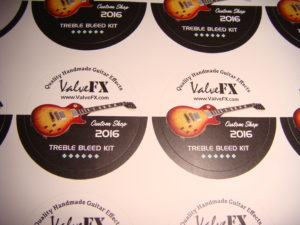 Resistors are IN PARALLEL with their capacitor unless stated otherwise
Resistors are IN PARALLEL with their capacitor unless stated otherwise
PRS – 180 pF cap (500 kΩ volume pot, no parallel/series resistor)
G&L – 200 pF (no resistor)
Bill Lawrence – 330 pF capacitor & 80 kΩ resistor
Mojo Tone – 471 pF capacitor & 220 kΩ resistor
DiMarzio – 560 pF capacitor & 300 kΩ resistor
John Suhr – 680 pF capacitor & 150kΩ resistor
TV Jones – 1 nF capacitor & 150 kΩ resistor (2 nF cap suggested for 500 kΩ pot, humbucker)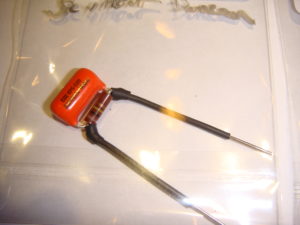
Fender – 1.2 nF capacitor & 150 kΩ resistor in parallel, plus a 20 kΩ resistor in series
Seymour Duncan – 1 nF capacitor & 100 kΩ resistor
Chris Kinman – 1.2 nF capacitor with 130 kΩ resistor in series
Lindy Fralin – 2.5 nF capacitor & 200 kΩ resistor
ValveFX – .0012uF & adjustable resistor from 100-200k
Rule of thumb: If you use a 10 ft cable from your guitar, choose the Mojo, DiMarzio, or Suhr values. If

you use a 30 ft cable choose one of the versions with 1 nF or 1.2 nf capacitor. See note 6 below.
Installation:
Probably the easiest part of the treble bleed modification is the installation. See the diagram? simply solder the connection to your volume pot or volume pot(s) as shown. Guitars with two volume controls will need two circuits.
Notes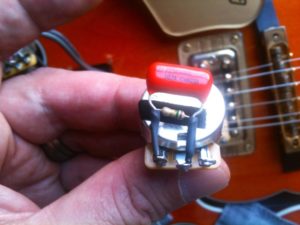
For capacitor value conversions, 1000 pF (picofarads) = 1 nF (nanofarad) = 0.001 µF (microfarad). For treble bleed mods, very small value caps are used, usually 1000 pF (1 nF) or less. For comparison, the most common capacitors used for tone controls are significantly larger; 0.022 µF and 0.047 µF. (i.e. 22 nF and 47 nF).
And yes, it would be much easier if we all just worked in nanofarads.
Treble bleed mod can have NO effect on your guitar tone when the volume pot is on 10 as the capacitor (and its resistor if present) are short circuited.
Guitars with active pickups or a buffer preamp onboard the guitar do not usually require a treble bleed mod.
The simplest treble bleed mod is to use a low value capacitor on it’s own. For many people this may not be particularly satisfactory – the tone of your guitar may become noticeably or even horribly bright as you roll down the volume (the opposite of the original problem). However, an advantage of the single capacitor option is that the taper of the volume pot does not change, i.e. the change in volume across the sweep of the volume pot is unchanged from the stock un-bypassed state.
PRS guitars actually choose this approach, and install a 180 pF bypass cap as standard on many of their guitars (usually with humbuckers and 500 kΩ volume and tone pots).
The Gibson “50’s wiring” can have a similar effect to a lone capacitor (some suggest even more neutral) BUT the effect of the guitars volume and tone controls are now interactive (e.g. the tone control can produce changes in volume) which some people find to be a drawback.
Adding a resistor in parallel with a larger value capacitor helps to keep the guitar tone more balanced as the volume pot is decreased and corrects the issue of too much treble from a lone capacitor. The lower the value of this bypass resistor, the less the capacitor passes treble at low volume settings. Conversely, the higher the value of the resistor, the more treble is passed by the capacitor.
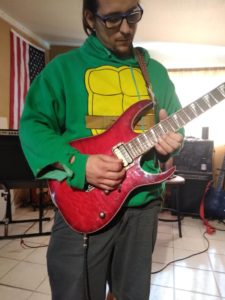 However, a parallel resistor affects the taper of the volume pot. This results in a more gradual change of volume across the range of the volume knob (i.e. it will give you less volume change between 10 and 7 and a faster volume change between 1 and 3). Personally, I am long used to this and find un-altered circuits change volume too drastically without it. Volume swells can be less smooth at the lowest numbers on the volume knob, particularly for high gain players. No such thing as a free lunch, eh? Everything is a compromise, all the time. Some of this change can addressed with the Fender mod of adding an additional series capacitor in the 20 kΩ to 50kΩ range. (see note 6 below).
However, a parallel resistor affects the taper of the volume pot. This results in a more gradual change of volume across the range of the volume knob (i.e. it will give you less volume change between 10 and 7 and a faster volume change between 1 and 3). Personally, I am long used to this and find un-altered circuits change volume too drastically without it. Volume swells can be less smooth at the lowest numbers on the volume knob, particularly for high gain players. No such thing as a free lunch, eh? Everything is a compromise, all the time. Some of this change can addressed with the Fender mod of adding an additional series capacitor in the 20 kΩ to 50kΩ range. (see note 6 below).
For those of you who don’t like how the parallel mod affects the volume pot taper, and the volume changes too slowly for your liking, a capacitor and resistor in series (e.g Chris Kinman‘s mod) gives a less drastic change in volume taper but the tone of the guitar may changes in a different way as the volume pot is turned down. This series combination passes a little more midrange than the equivalent parallel circuit. It feels a little like dialing back the bass and treble a touch. You may or may not notice this tonal difference between parallel and series resistors, you may prefer one over the other, and may prefer the taper change of one over the other, so feel free to experiment and let your ears tell you what works best for you.
When testing, if possible, do A-B recordings (even the voice recorder on your phone is useful for this) and try to use the same volume settings on the guitar. Stratocaster style volume knobs are useful here but a small piece of tape and marker can be useful on knobs without numeric markings.
The capacitor/resistor values that work best for you will generally depend on your total cable capacitance, which is related to the total length of cable your guitar. That in mind, and based on my circuit modelling, my current rule of thumb is as follows:
If you use a 10 ft cable from your guitar, choose the Mojo Tone, DiMarzio, or Suhr values. If you use a 30 ft cable choose one of the versions with 1 nF or 1.2 nf capacitor.
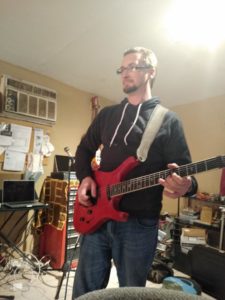 You may have to experiment to achieve what your ears will regard as the perfect combination for your setup. But that’s just not that easy to do for most people nor a particularly efficient use of time. The good news is that most people who are bothered by the loss of treble at lower volume pot settings will be very happy with many of the above choices. If the result is too bright choose a larger value capacitor (and a lower value if the result is too dark). But the values are not particularly critical because of the lack of sensitivity of our ears to some of the differences between the choices above, and the fact that when playing real music we don’t pay attention to those kind of details. You don’t have spend time trying to figure out what the perfect choice might be, just dive in.
You may have to experiment to achieve what your ears will regard as the perfect combination for your setup. But that’s just not that easy to do for most people nor a particularly efficient use of time. The good news is that most people who are bothered by the loss of treble at lower volume pot settings will be very happy with many of the above choices. If the result is too bright choose a larger value capacitor (and a lower value if the result is too dark). But the values are not particularly critical because of the lack of sensitivity of our ears to some of the differences between the choices above, and the fact that when playing real music we don’t pay attention to those kind of details. You don’t have spend time trying to figure out what the perfect choice might be, just dive in.
The TV Jones values (1 nF & 150 kΩ) are recommended by many sources as a good choice for maintaining a consistent resonant peak as volume decreases: e.g. John Hewitt (in his simulation work here); and recommended by the excellent people at Ann Arbor Guitars in their video here. (Incidentally Ann Arbor Guitars have some great videos on their YouTube channel, including this great explanation of treble bleed circuits).
These values (1 nF & 150 kΩ) are sold by Stew Mac and ValveFX as a their “Golden Age Treble Bleed Circuit”.
Fender have recently marketed a “Tone Saver” that they sometimes claim is not a simple treble bleed circuit, sometimes claim is a simple treble bleed circuit. but when cut open features, can you guess? Yep, a 1.2 nF cap and a 130 kΩ resistor in a fancy package that costs 10 times more than the practically identical Stew Mac product. Shame on you Fender! Almost as expensive as a Gibson fake bumblebee cap (see note no 9 below).
Interestingly though, in Fender‘s current American professional series guitars they have a new combination, which is a 1.2nF cap, 130kΩ parallel resistor, and a 20kΩ series resistor. The extra little series resistor is interesting. Without we can already maintain the resonant frequency and peak height with standard parallel bypass components. This extra series resistor doesn’t make much difference tonally (because most of the above noted values already do a good job without it and the ear won’t be very sensitive to the differences). But it does restore some of the change in the taper of the volume pot closer to it’s stock characteristics.
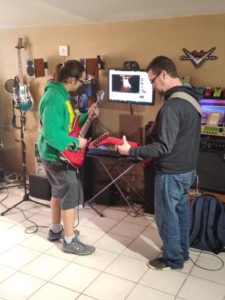 Pickup maker Jason Lollar recommends no treble bleed at all but suggests a smaller value tone cap or even Gibson 50’s tone pot wiring. He has stated that even with the volume knob on 10 the treble bypass circuit will affect your tone. But his statements are completely contrary to long time tried-and-tested basic electronics knowledge. True, some people prefer the Gibson/50’s tone pot mod. But a smaller value cap on the tone pot has no bearing on treble loss at low volume pot settings if you use standard wiring. And, as the bypass cap/resistor are completely short circuited when the volume pot is on 10 they cannot have any effect on the circuit or your tone. I suggest you ignore Lollar’s statements on this particular subject.
Pickup maker Jason Lollar recommends no treble bleed at all but suggests a smaller value tone cap or even Gibson 50’s tone pot wiring. He has stated that even with the volume knob on 10 the treble bypass circuit will affect your tone. But his statements are completely contrary to long time tried-and-tested basic electronics knowledge. True, some people prefer the Gibson/50’s tone pot mod. But a smaller value cap on the tone pot has no bearing on treble loss at low volume pot settings if you use standard wiring. And, as the bypass cap/resistor are completely short circuited when the volume pot is on 10 they cannot have any effect on the circuit or your tone. I suggest you ignore Lollar’s statements on this particular subject.
Guitar signals are tiny, the voltages involved are very small. This means that the voltage rating of the capacitors is of no importance.
You can use whatever voltage rating you like but while higher voltage rating components are physically larger and little easier to handle, lower voltage rating caps are a better fit in tight spaces such as guitar control cavities.